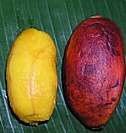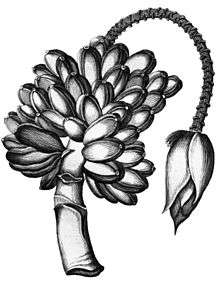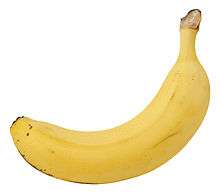Fe'i banana
| Fe'i bananas | |
|---|---|
 Peeled and unpeeled Karat bananas | |
| Genus | Musa |
| Species | M. × troglodytarum L. |
| Hybrid parentage | Species in Musa section Callimusa |
| Cultivar group | Fe'i Group |
| Origin | Pacific islands, initially New Guinea? |
Fe'i bananas (also spelt Fehi or Fei) are cultivated plants in the genus Musa, used mainly for their fruit. They are distinct in appearance and origin from the majority of bananas and plantains currently grown, which derive from different wild species. Found mainly in the islands of the Pacific, particularly French Polynesia, Fe'i bananas have skins which are brilliant orange to red in colour with yellow or orange flesh inside. They are usually eaten cooked and have been an important food for Pacific Islanders, moving with them as they migrated across the ocean. Most are high in beta-carotene (a precursor of Vitamin A).
The scientific name for Fe'i bananas is Musa × troglodytarum L. Precisely which wild species they are descended from remains unclear as of January 2013.
Description

Fe'i bananas are cultivated varieties (cultivars), rather than wild forms. They are distinctly different from the much more common bananas and plantains derived from Musa acuminata and Musa balbisiana.[1] All members of the genus Musa are tall herbaceous plants, typically around 3–10 m (10–33 ft) tall or even more. Although they appear tree-like, the "trunk" is actually a pseudostem, formed from the tightly wrapped bases of the leaves. At maturity each pseudostem produces a single flowering stem that grows up inside it, eventually emerging from the top. As it elongates, female flowers appear which go on to form fruit – the bananas. Finally male flowers are produced. In cultivated bananas, the fruit is usually seedless and the male flowers sterile.[2]
Fe'i bananas can be distinguished from other kinds of cultivated bananas and plantains in a number of ways. They have highly coloured sap, pink through to bright magenta and dark purple. The bracts of the flowering spike (inflorescence) are bright shiny green rather than dull red or purple. The flowering and fruiting stem is more or less upright (rather than drooping), so that the bunches of bananas are also upright. Ripe fruit has brilliant orange, copper-coloured or red skin with orange or yellow flesh inside. It has prominent ridges, making it squarish in cross-section.[1][3]
Systematics

As with many names in the genus Musa, considerable confusion has existed as to the proper scientific name, if any, for Fe'i bananas. Some authorities have preferred to treat Fe'i bananas as a formal or informal cultivar group rather than employing a Latin binomial, using names like Musa (Fe'i Group) 'Utafan'.[5]
One of the earliest detailed accounts of the genus Musa was by the German-Dutch botanist Georg E. Rumpf (c.1627–1702), usually known by the Latinized name Rumphius. His Herbarium amboinensis was published in 1747, after his death. His figure and description of a "species" under the name "Musa Uranoscopos" (meaning "heaven-looking banana") is consistent with a Fe'i banana; he refers to the upright flowering spike (although the figure, reproduced here, shows the terminal bud drooping), the coloured sap, and the effect of consumption on urine.[4]
However, the starting point for botanical names is the publication of Carl Linnaeus' Species Plantarum in 1753, so "Musa uranoscopos" is not an acceptable name. In the second edition of Species Plantarum, Linnaeus lumped together Rumphius' Musa uranoscopos and Musa 'Pissang Batu' under the name Musa troglodytarum, in spite of the fact that Rumphius had noted several distinctions between the two. Linnaeus' treatment has been described as "beyond understanding".[6] In 1917, Merrill designated the illustration of Rumphius' Musa uranoscopos as the lectotype of Musa troglodytarum L. On this basis, Häkkinen, Väre and Christenhusz concluded in 2012 that "all Fe'i cultivars, including those featured in Paul Gauguin's famous paintings, should be treated under the name M. troglodytarum L."[6] Other sources also accept this as the scientific name for the group as a whole – for example Rafaël Govaerts in 2004.[7] The name may be written as M. × troglodytarum to stress the hybrid origin of Fe'i bananas.
Synonyms of M. troglodytarum are:[6][8]
- "M. uranoscopos" Rumphius (1747) – published before 1753, so not an acceptable name
- M. uranoscopos Lour. (1790) – a superfluous name because it was provided as an alternative name to Linnaeus', hence illegitimate; Loureiro's description is based on a different plant, M. coccinea
- M. uranoscopos Colla (1820) – superfluous and hence illegitimate
- M. uranoscopos Mig. (1855) – superfluous and hence illegitimate
- M. uranoscopos Seem. (1868) – superfluous and hence illegitimate
- M. seemannii Mueller (1875) – superfluous and hence illegitimate
- M. fehi Bertero ex Vieillard (1862)
Whereas most cultivated bananas and plantains are derived from species in Musa section Musa, Fe'i bananas are clearly part of section Callimusa (in particular the species formerly grouped as section Australimusa).[9] However, their precise origins are unclear. On the basis of appearance (morphology), Musa maclayi, native to Papua New Guinea has been proposed as a parent. More recent genetic studies suggest they are close to M. lolodensis and M. peekelii, both from New Guinea and neighbouring islands. Fe'i bananas may be hybrids between several different wild species.[1] They are generally considered to have originated in New Guinea and then to have been spread eastwards and northwards (as far as the Hawaiian Islands) for use as food.[3]
A few cultivars have been found which appear to be intermediate between Fe'i bananas and the more common Musa section Musa bananas and plantains. Although the part of the stem holding the fruit is upright, the rest of the stem then bends over so that the terminal bud faces sideways or downwards. An example is the cultivar 'Tati'a' from Tahiti. Molecular analysis of bananas with this growth habit from Papua New Guinea has shown evidence of genetic input from M. acuminata and M. balbisiana, the parents of the section Musa cultivars.[3] Rumphius' illustration of his "Musa uranoscopos" shows the same morphology, although this might be artistic license.[6]
Distribution

Fe'i bananas are mainly found from the Moluccas in the west to French Polynesia in the east, particularly the Society Islands and the Marquesas. They have been important both as a staple and as a ceremonial food, although their cultivation and use has sharply declined in recent decades. As the Pacific Islanders spread by canoe throughout the Pacific, they took Fe'i bananas with them; cultivation has been traced back to around 250 BC in the Marquesas and to around 800 AD in Tahiti in the Society Islands.[1] They are believed to have originated in the New Guinea area, where cultivars with seeds occur, as do the wild species from which they are thought to be descended.[3]
Cultivars
Fe'i bananas are not in commercial cultivation. There are lists of cultivars for different islands, but it is not clear whether these are synonyms, with the same cultivar being known by different names in different locations and languages.[1][2] Further, it is not clear whether local names apply to cultivars (i.e. distinct cultivated varieties) or to broader groups. Thus Ploetz et al. refer to a banana found in eastern Indonesia by the cultivar name 'Pisang Tongkat Langit'.[1] However, pisang tongkat langit can be translated as "sky stick banana" or "heaven cane banana",[10] corresponding to Rumphius' name Musa uranoscopos (heaven-gazing banana). Pisang tongkat langit is treated by other sources as referring to M. × troglodytarum as a whole rather than to a single cultivar. Significant genetic variation has been reported among bananas from the Moluccas for which this name is used.[11]
The list below is selective; where many names are given in sources, it concentrates on those with the most description available.
- Karat type cultivars
- 'Karat Kole' or 'Karat Pwono' – round-shaped banana, flesh orange-yellow
- 'Karat Pako' – longer banana, skin rough, flesh orange-yellow
- 'Karat Pwekhu' – smaller banana, flesh orange-yellow
- Utin Iap type cultivars
- 'Utin Iap' or 'Uht En Yap' – cone-shaped bunch, small bananas, flesh orange
- 'Utimwas' – small bananas, flesh orange
- Solomon Islands:[14]
- 'Aibwo' or 'Suria' – ripe skin orange; flesh yellow-orange
- 'Fagufagu' – ripe skin orange, flesh yellow-orange
- 'Gatagata' or 'Vudito' – ripe skin orange-brown, flesh yellow-orange
- 'Toraka Parao' – ripe skin red; flesh yellow-orange
- 'Warowaro' – ripe skin brown; flesh yellow
- Eastern Indonesia:[1]
- 'Pisang Tongkat Langit'
- Papua New Guinea:[1]
- 'Menei', 'Rimina', 'Utafan', 'Sar', 'Wain'
- New Caledonia:[1]
- 'Daak'
- Fiji:[1]
- 'Soaqa'
- Society Islands:[1]
- 'Fe'i Aiuri', 'Fe'i Tatia'
- Hawai'i:[1]
- 'Borabora', 'Polapola', 'Mai'a Ha'i'
Use
As food
Fe'i bananas are generally eaten as "plantains", i.e. they are usually cooked rather than eaten raw. They have been described as "delicious and nutritious when baked or boiled, especially if the slices are swathed in fresh coconut cream."[15] They have also been described as "unpleasantly astringent" unless cooked, having higher proportions of starch and lower proportions of sugar than other kinds of banana.[3] However, in the Federated States of Micronesia, some cultivars, particularly 'Karat Pwehu', 'Karat Pako' and to a lesser extent 'Utin Iap' (='Uht En Yap'), are commonly eaten raw when fully ripe. Karat bananas have a soft texture and a sweet taste and were a traditional weaning food in the Micronesian island of Pohnpei.[12]
In countries where Fe'i bananas were once a major food item, there has been a shift away from eating traditional foods towards eating imported foods. Bananas with whiter flesh are preferred over traditional varieties with deeply coloured flesh.[12] One issue with Fe'i bananas is that eating them causes the production of yellow coloured urine, thought to be caused by the excretion of excess riboflavin present in the fruit. This effect led people to believe that Fe'i bananas might not be safe to eat, particularly for children.[14] Along with the shift away from traditional foods, there has been a rise in Vitamin A deficiency. Fe'i bananas with deeper coloured flesh have been shown to contain high levels of beta-carotene, a precursor of Vitamin A. A year-long promotional campaign in Pohnpei in 1999 to encourage the consumption of Karat cultivars had some success in increasing sales.[12]
Levels of beta-carotene vary considerably among Fe'i bananas. In a study of traditional Solomon Islands cultivars, the highest level of beta-carotene found in a Fe'i cultivar was almost 6,000 µg per 100 g of flesh compared to the highest level of 1,300 µg in a non-Fe'i cultivar. However, there was an overlap; some Fe'i cultivars contained less beta-carotene than non-Fe'i cultivars.[14]
Other uses
Fe'i banana plants have many other uses. Like other kinds of banana, the leaves may be used as plates or containers for cooked food. They can also be used as a roofing material, particularly for temporary huts. The fibres of the midrib of the leaves can be used to make ropes, often used to carry bunches of bananas. Other fibrous parts of the leaves can be dried and plaited into mats and similar items. The pseudostems are buoyant, and so can be used to make temporary rafts.[3]
Fe'i bananas have distinctive reddish sap which does not readily fade on exposure to light. It is used as a dye, and has also been used to make ink.[3]
Historical reports
The early European explorers of the Pacific islands produced a few accounts of Fe'i bananas. In 1788, Daniel Solander accompanied Joseph Banks on James Cook's first voyage to the Pacific Ocean aboard the Endeavour. In the account he published later, he noted five kinds of banana or plantain called "Fe'i" by the Tahitians. William Ellis lived in the Society Islands in the 1850s. He refers to the name "Fe'i", saying that Fe'i bananas were the principal food for the inhabitants of some islands. He also noted that Fe'i banana plants have an upright fruit cluster.[3]
Charles Darwin visited Tahiti in the Society Islands in 1835 and gave an account in The Voyage of the Beagle. Although he does not mention the name "Fe'i", he does speak of the "mountain-banana": "On each side of the ravine there were great beds of the mountain-banana, covered with ripe fruit. Many of these plants were from twenty to twenty-five feet high, and from three to four in circumference."[16] Fe'i bananas have been noted to grow best in Tahiti on slopes at the base of cliffs.[3]
Laurence H. MacDaniels published a study of the Fe'i banana in 1947. He reported that Fe'i bananas were the staple carbohydrate food of the Society Islanders, and that more than 95% of the bananas on sale were of the Fe'i type. Although some Fe'i banana plants were found in gardens, most bananas were gathered from the "wild", thought to have been planted in the past and abandoned.[17]
In culture

Fe'i bananas are an important component of ceremonial feasts in the Marquesas and the Society Islands.[3] Karat bananas are reported to be one of the few kinds of banana that can be used in ceremonial presentations in Pohnpei, Micronesia.[12] A Samoan legend is that the mountain and the lowland banana fought. The mountain banana – the Fe'i banana – won. Filled with pride at its victory, the mountain banana raised its head high, whereas the defeated lowland banana never raised its head again.[3] (Fe'i bananas have an upright fruiting stem, whereas the fruiting stem droops in other kinds of banana.)
The bright orange-red colours of Fe'i bananas make them attractive to artists. The French post-impressionist painter Paul Gauguin visited the Society Islands, including Tahiti, towards the end of the 19th century. Three of his works include what are considered to be Fe'i bananas: Le Repas (The Meal, 1891), La Orana Maria (Hail Mary, 1891) and Paysage de Tahiti (Tahitian Landscape, 1891[Note 2]).[3]
Conservation
Fe'i banana cultivars, along with other Pacific crop propagation material, have been saved at the Centre for Pacific Crops and Trees (CePaCT), which catalogs living plants of the Pacific region for conservation. More than 100 samples of Fe'i bananas were collected in French Polynesia, from isolated farms on six different islands. The samples will be conserved in a gene bank in Tahiti, with duplicates kept at CePaCt.[18]
Notes
- ↑ The map is based on Sharrock (2001, p. 3) with the Federated States of Micronesia added based on Englberger (2003).
- ↑ There are several paintings by Gaugin with similar titles. Although Sharrock (2001) gives the date as 1892, it is the painting of 1891 that shows a man apparently carrying orange bananas. See Tahitian Landscape, 1891, The Web Gallery of Impressionism, retrieved 2013-01-22 External link in
|publisher=(help).
References
- 1 2 3 4 5 6 7 8 9 10 11 12 Ploetz, R.C.; Kepler, A.K.; Daniells, J. & Nelson, S.C. (2007), "Banana and Plantain: An Overview with Emphasis on Pacific Island Cultivars", in Elevitch, C.R, Species Profiles for Pacific Island Agroforestry (PDF), Hōlualoa, Hawai'i: Permanent Agriculture Resources (PAR), retrieved 2013-01-10
- 1 2 Nelson, S.C.; Ploetz, R.C. & Kepler, A.K. (2006), "Musa species (bananas and plantains)", in Elevitch, C.R, Species Profiles for Pacific Island Agroforestry (PDF), Hōlualoa, Hawai'i: Permanent Agriculture Resources (PAR), retrieved 2013-01-10
- 1 2 3 4 5 6 7 8 9 10 11 12 Sharrock, S. (2001), "Diversity in the genus Musa: focus on Australimusa", in INIBAP, Networking Banana and Plantain: INIBAP Annual Report 2000 (PDF), Montpellier, France: International Network for the Improvement of Banana and Plantain, pp. 14–19, archived from the original (PDF) on 2013-05-13, retrieved 2013-01-22
- 1 2 Rumpf, Georg Eberhard (1747), Herbarium amboinense, vol. 5 (in Latin and Dutch), Amsterdam: François Changuion, Hermanus Uytwerf, retrieved 2013-01-24, p. 137 and tab. 60 fig. 2
- ↑ "Search for 'Fe'i Group'", Horticultural Database, Royal Horticultural Society, retrieved 2013-01-28
- 1 2 3 4 Häkkinen, M.; Väre, H. & Christenhusz, M.J.M. (2012), "Identity of a Pisang – historical concepts of Musa (Musaceae) and the reinstatement of Musa troglodytarum", Folia malaysiana, 13 (2): 1–14
- ↑ "Musa troglodytarum", World Checklist of Selected Plant Families, Royal Botanic Gardens, Kew, retrieved 2013-01-20
- ↑ Häkkinen, M. & Väre, H. (2008), "Typification and check-list of Musa L. names (Musaceae) with nomenclatural notes", Adansonia, sér. 3, 30 (1): 63–112
- ↑ Wong, C.; Kiew, R.; Argent, G.; Set, O.; Lee, S.K. & Gan, Y.Y. (2002), "Assessment of the Validity of the Sections in Musa (Musaceae) using ALFP", Annals of Botany, 90 (2): 231–238, doi:10.1093/aob/mcf170
- ↑ English • Indonesian • English dictionary, Kamus.net, STANDS4 LLC, retrieved 2013-01-27
- ↑ Karuwal, Ritha Lusian (2011), Variasi Genetik Pisang Tongkat Langit (Musa troglodytarum L.) Berdasarkan Karakter Morfologis dan Molekular (unpublished thesis) (in Indonesian and English), Yogyakarta: Universitas Gadjah Mada
- 1 2 3 4 5 Englberger, Lois (2003), "Carotenoid-rich bananas in Micronesia" (PDF), InfoMusa, 12 (2): 2–5, retrieved 2013-01-22
- ↑ Englberger, Lois & Lorens, Adelino Lorens (2004), Pohnpei-bananas: a photo collection: carotenoid-rich varieties (PDF), Suva, Fiji Islands: Secretariat of the Pacific Community, ISBN 978-982-00-0038-4, retrieved 2013-01-22
- 1 2 3 Englberger, Lois; Lyons, Graham; Foley, Wendy; Daniells, Jeff; Aalbersberg, Bill; Dolodolotawake, Usaia; Watoto, Claudine; Iramu, Ellen; Taki, Belden; Wehi, Francis; Warito, Peter; Taylor, Mary (2010), "Carotenoid and riboflavin content of banana cultivars from Makira, Solomon Islands", Journal of Food Composition and Analysis, 23 (6): 624–632, doi:10.1016/j.jfca.2010.03.002
- ↑ Ploetz et al. 2007, p. 3
- ↑ Darwin, Charles (1845), Journal of researches into the natural history and geology of the countries visited during the voyage of H.M.S. Beagle round the world, under the command of Capt. Fitz Roy, R.N., London: John Murray, OCLC 4019859, chapter 18
- ↑ MacDaniels, L.H. (1947), A study of the Fe’i banana and its distribution with reference to Polynesian migrations, Bernice P. Bishop Museum Bulletin 190, Honolulu, Hawaii, OCLC 5223876, cited in Sharrock 2001
- ↑ Efforts underway to rescue vulnerable bananas, giant swamp taro, other Pacific Island crops, Burness Communications, 21 Oct 2010, retrieved 2013-06-22
